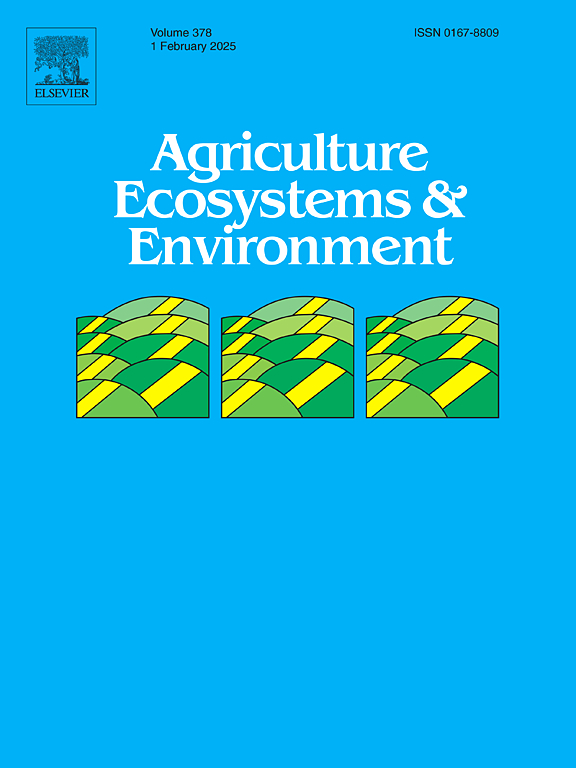Soil metagenomics reveals reduced tillage improves soil functional profiles of carbon, nitrogen, and phosphorus cycling in bulk and rhizosphere soils
IF 6
1区 农林科学
Q1 AGRICULTURE, MULTIDISCIPLINARY
引用次数: 0
Abstract
Conservation tillage practices (CAT) are known to benefit soil health and soil ecosystem functions relative to conventional tillage (CVT); however, much uncertainty remains concerning microbial functional traits and their subsequent effects on soil nutrients under different tillage practices. We analyzed the functional profiles of the C, N, and P cycles in response to CAT of no-tillage (NT), reduced tillage (RT), and CVT of moldboard plowing (MP) in bulk and rhizosphere soils using shotgun sequencing. CAT induced distinct microbial functional patterns relative to CVT, and these differences were generally more evident in rhizosphere soils than in bulk soils. CAT promotes multiple metabolic pathways such as C and N decomposition, fermentation, CO oxidation, N fixation, nitrate reduction and inorganic-P and organic-P transformations in bulk and/or rhizosphere soils. Variations in these metabolic pathways were mainly driven by Bradyrhizobium, Mesorhizobium, Nitrososphaera, Phenylobacterium, Rhizobium which are affiliated with Proteobacteria, Actinobacteria, Acidobacteria, Bacteroidota and Thaumarchaeota. Furthermore, 24 high-quality metagenome-assembled genomes (MAGs) were reconstructed, of which three novel MAGs (TL100, TL46, and TL57) harbored functional genes regulating all metabolic pathways. In particular, NT-enriched MAGs (such as Sphingomonas) promote fermentation, resulting in the reduction of soil total carbon (TC) relative to MP in bulk soils. RT retained the contents of soil TC and total nitrogen (TN) well and up-regulated the phoR gene carried by Streptomyces, which promoted the regulation of P-starvation concomitantly with the increase in the contents of total phosphorous (TP) and available phosphorous (AP) in bulk soil. Additionally, assimilatory nitrate reduction coupled with organic-P mineralization was facilitated by CAT in rhizosphere soil, leading to the mitigation of N loss and the activation of soil organic-P for crop uptake. Overall, our results revealed that CAT significantly accelerated multiple metabolic potentials, and RT could sustain soil nutrient contents better than NT.
土壤元基因组学揭示了减少耕作可改善大体积土壤和根圈土壤中碳、氮和磷循环的土壤功能特征
众所周知,相对于传统耕作(CVT),保护性耕作方法(CAT)有利于土壤健康和土壤生态系统功能;然而,在不同耕作方法下,微生物功能特征及其对土壤养分的后续影响仍存在很多不确定性。我们利用霰弹枪测序技术分析了免耕(NT)、减耕(RT)和模板犁(MP)等传统耕作法对大块土壤和根瘤土壤中 C、N 和 P 循环的功能特征。相对于 CVT,CAT 诱导了不同的微生物功能模式,这些差异在根瘤土壤中比在大面积土壤中更为明显。CAT 可促进多种代谢途径,如块状和/或根圈土壤中的碳和氮分解、发酵、一氧化碳氧化、氮固定、硝酸盐还原以及无机-磷和有机-磷转化。这些代谢途径的变化主要是由隶属于蛋白细菌、放线菌、酸性细菌、类杆菌科和潮气菌科的布拉迪根瘤菌、中生代根瘤菌、硝化细菌、苯基杆菌、根瘤菌所驱动的。此外,还重建了 24 个高质量的元基因组组装基因组(MAGs),其中 3 个新型 MAGs(TL100、TL46 和 TL57)含有调控所有代谢途径的功能基因。特别是,富含 NT 的 MAG(如鞘氨醇单胞菌)能促进发酵,导致土壤总碳(TC)相对于大体积土壤中的 MP 而减少。RT 很好地保留了土壤总碳和全氮的含量,并上调了链霉菌携带的 phoR 基因,这促进了对磷饥饿的调节,同时增加了大体积土壤中的全磷(TP)和可利用磷(AP)的含量。此外,CAT 还促进了根瘤菌土壤中硝酸盐的同化还原和有机磷的矿化,从而减少了氮的流失,并激活了土壤中的有机磷供作物吸收。总之,我们的研究结果表明,CAT 显著加速了多种代谢潜能,RT 比 NT 更能维持土壤养分含量。
本文章由计算机程序翻译,如有差异,请以英文原文为准。
求助全文
约1分钟内获得全文
求助全文
来源期刊

Agriculture, Ecosystems & Environment
环境科学-环境科学
CiteScore
11.70
自引率
9.10%
发文量
392
审稿时长
26 days
期刊介绍:
Agriculture, Ecosystems and Environment publishes scientific articles dealing with the interface between agroecosystems and the natural environment, specifically how agriculture influences the environment and how changes in that environment impact agroecosystems. Preference is given to papers from experimental and observational research at the field, system or landscape level, from studies that enhance our understanding of processes using data-based biophysical modelling, and papers that bridge scientific disciplines and integrate knowledge. All papers should be placed in an international or wide comparative context.
 求助内容:
求助内容: 应助结果提醒方式:
应助结果提醒方式:


